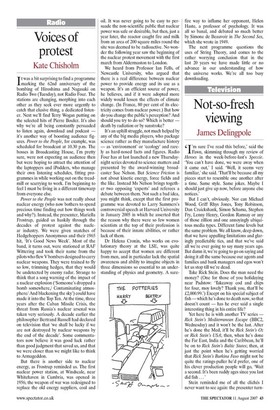Voices of Protest Kate Chisholm It was a bit surprising
to find a programme marking the 62nd anniversary of the bombing of Hiroshima and Nagasaki on Radio Two (Tuesday), not Radio Four. The stations are changing, morphing into each other as they seek ever more urgently to catch that elusive thing, a dedicated listener. Next we'll find Terry Wogan putting on the selected hits of Pierre Boulez. It's also why we're all being constantly persuaded to listen again, download and podcast — it's another way of boosting audience figures. Power to the People, for example, was scheduled for broadcast at 10.30 p.m. The bosses in Broadcasting House, I'm pretty sure, were not expecting an audience then but were hoping to attract the attention of the laptoppers and iPodders, who manage their own listening schedules, fitting programmes in while working out on the treadmill or scurrying to work. I'm beginning to feel I must be living in a different timewarp from everyone else.
Power to the People was not really about nuclear energy (who now bothers to spend precious time finding out how things work and why?). Instead, the presenter, Mariella Frostrup, guided us huskily through the decades of protest against the nuclear industry. We were given snatches of Hedgehoppers Anonymous and their 1965 hit, 'It's Good News Week'. Most of the band, it turns out, were stationed at RAF Wittering and took their name from the pilots who flew V bombers designed to carry nuclear weapons. They were trained to fly so low, trimming hedges, that they would be undetected by enemy radar. Strange to think that a song warning of the impact of a nuclear explosion (Someone's dropped a bomb somewhere,/ Contaminating atmosphere/ And blackening the sky') could have made it into the Top Ten. At the time, three years after the Cuban Missile Crisis, the threat from Russia's nuclear arsenal was taken very seriously. A decade earlier the philosopher Bertrand Russell had declared on television that 'we shall be lucky if we are not destroyed by nuclear weapons by the end of the decade'. Some commentators now believe it was good luck rather than good judgment that saved us, and that we were closer than we might like to think to Armageddon.
But there is another side to nuclear energy, as Frostrup reminded us. The first nuclear power station, at Windscale, near Whitehaven in Cumbria, was opened in 1956; the weapon of war was redesigned to replace the old energy suppliers, coal and oil. It was never going to be easy to persuade the non-scientific public that nuclear power was safe or desirable, but then, just a year later, the reactor caught fire and milk from an area of 200 square miles round the site was deemed to be radioactive. No wonder the following year saw the beginning of the nuclear protest movement with the first march from Aldermaston to London.
We heard from Professor Ian Fells, of Newcastle University, who argued that there is a real difference between nuclear power to provide energy and its use as a weapon. It's an efficient source of power, he believes, and if it were adopted more widely would lessen the effects of climate change. (In France, 80 per cent of its electricity comes from nuclear power.) But how do you change the public's perception? And should you try to do so? Which is better — death by radiation or by sunstroke?
It's an uphill struggle, not much helped by any of the big media players, who package science rather as they manufacture history — as 'environment' or 'ecology' and rarely as hard-nosed facts and figures. Radio Four has at last launched a new Thursdaynight series devoted to science matters and presented by the award-winning broadcaster Sue Nelson. But Science Friction is not about kinetic energy, force fields and the like. Instead Ms Nelson brings together two opposing 'experts' and referees a debate between them. Not such a bad idea, you might think, except that the first programme was devoted to Larry Summers's controversial speech at Harvard University in January 2005 in which he asserted that the reason why there were so few women scientists at the top of their profession is because of their innate abilities, or rather lack of them.
Dr Helena Cronin, who works on evolutionary theory at the LSE, was quite happy to accept that women are different from men, and in particular lack the spatial awareness and ability to imagine objects in three dimensions so essential to an understanding of physics and geometry. A sure fire way to inflame her opponent, Helen Haste, a professor of psychology. It was all so banal, and debated so much better by Simone de Beauvoir in The Second Sex, which she wrote in 1949.
The next programme questions the uses of String Theory, and comes to the rather worrying conclusion that in the last 20 years we have made little or no advance in our understanding of how the universe works. We're all too busy downloading.









































 Previous page
Previous page